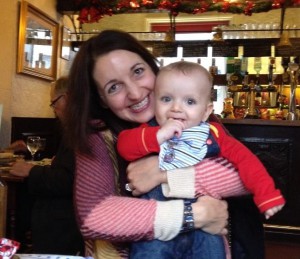 I suspect that for nearly all women, soon after our first-born makes the exit out of our bodies and into the world, a “guilt cyst” begins to grow inside us — metaphorically speaking, that is.
I suspect that for nearly all women, soon after our first-born makes the exit out of our bodies and into the world, a “guilt cyst” begins to grow inside us — metaphorically speaking, that is.
When my first child was born, I quit my job and became a stay-at-home mom. That decision came as a surprise to me, but it felt right at the time.
However, once the overwhelming feelings of immense responsibility and sheer exhaustion subsided, guilt started take over. I felt guilty for my lack of financial contribution to our household. With me not working — in the “professional sense,” that is, because we all know that stay-at-home parenting is work! — we lost 50% of our combined income.
A few years later, another nagging feeling started to creep in: I missed having professional ambitions and a career. I felt guilty for not being a career woman.
One afternoon at a friend’s house, over a nice glass of wine, my friend Heather and I had a heart-to-heart conversation. Heather is a sweet, shrewd businesswoman. She is married, has three kids and a live-in nanny. She confided in me that she envied me and our stay-at-home mom friends. She explained that, unlike her, we get to spend time together and we are able to dedicate a lot of our time to our kids and attend their school activities. She added that she felt guilty for spending so much time away from her kids while her nanny spends a lot of time with them.
I responded that I envied her for having a career, for being able to drink a cup of coffee while it’s still hot and for being able to walk around without a “shadow” following her every move. I added that I felt guilty for not working and I was wondering whether I provided my little girl with a good example of what a strong, independent woman should be like.
We went on and on until I tired of our kvetching. “Listen to us!” I said. “We are different women who made different choices for ourselves and our families. Why can’t we just accept our choices and live with the pros and cons, whatever they may be for each one of us?” We toasted to that and decided to move on.
I tried to move on. I thought I found the perfect solution in quest for more balance: I became a work-from-home mom!
I used to pride myself on being an excellent multi-tasker. It didn’t feel that way anymore.
Some days, I found myself drafting a work email, making dinner as I tried accommodating each of the family members’ often very different ideas for what should be served on their plates, helping my kids with their home and answering my husband’s texts, often responding to the dreaded message “What’s for dinner?” — all at one time!
At the same time, the thoughts and feelings circulating in my mind were along the lines of: I am underpaid for my contributions and skill set at work. I am depriving my family of a nice, elaborate dinner. I wonder if my kids sense that I am not fully present; I am certain they are feeling my agitation. I hope my husband is not thinking I am neglecting my “wifely duties.” Hey, I’m doing my best here!
I felt like I was doing so much, and I wasn’t excelling at any of it.
Then, I heard TV news anchor Barbara Walters say: “You can have it all — marriage, kids, career — just not at the same time.” That hit a nerve. I found it to be my truth. Nowadays, I am a stay-at-home mom, contemplating on the next chapter of my career.
More importantly, my “guilt cyst” subsided and is under control. I suspect I will never completely rid myself of it, but I am at peace with its existence. I attribute this acceptance to the support of my friend Heather and my growth as a being.
This subject of mother’s guilt over working or not is one that has been debated for many years and will be debated for as long as we have choices as mothers. I now decide to focus on how wonderful it is that we have choices.





